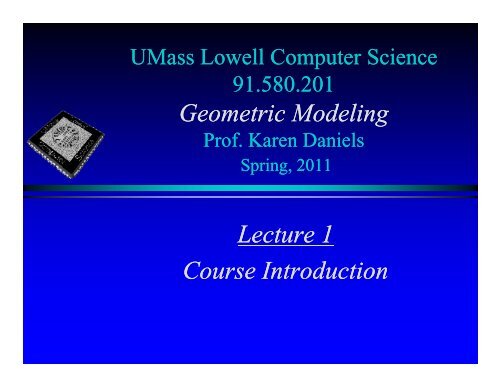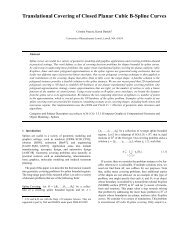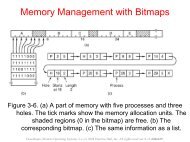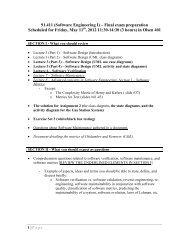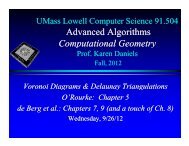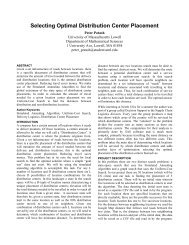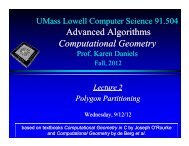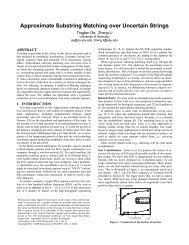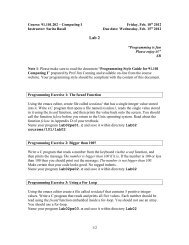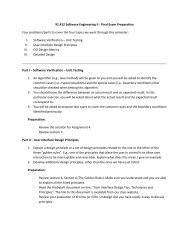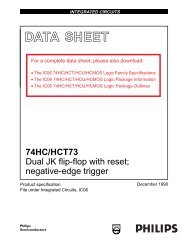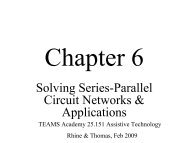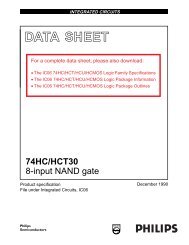Part 1 - Computer Science
Part 1 - Computer Science
Part 1 - Computer Science
You also want an ePaper? Increase the reach of your titles
YUMPU automatically turns print PDFs into web optimized ePapers that Google loves.
UMass Lowell <strong>Computer</strong> <strong>Science</strong>91.580.201Geometric ModelingProf. Karen DanielsSpring, 2011Lecture 1Course Introductionti
Course IntroductionWhat is Geometric Modeling?
Geometric Modeling: 91.580.201Thursdays 5:30-8:15, 815 Prof. DanielsMethods for representing and manipulating gggeometricobjects in a computational setting.Differential GeometryConstructiveSolidGeometryCourtesy of Cadence Design SystemsGeometric ModelingCourtesy of Stanford University<strong>Computer</strong>-AidedGeometric DesignComputational GeometryCourtesy of Silicon GraphicsAdapted from: Geometric Modeling by Mortenson
Sample Application AreasMedicalImagingGeographicInformation Systems& Spatial DatabasesCoveringVideoGames<strong>Computer</strong> GraphicsMeshing forFinite Element AnalysisTopological InvariantEstimationCADCourtesy of Cadence Design Systems
Geometric Model ExamplesCourtesy of Silicon GraphicsSwept SurfaceConstructive Solid GeometrySource: Mortenson
Model Examples (continued)Wireframe and Boundary Representation (B-Rep) ModelsSources: Hill /Kelley OpenGL and Mortenson
Model Examples (continued)Unstructured 3D Meshes (Rendered)Sources: Hill /Kelley OpenGL and Stanford Graphics LabMeshing for Finite Element AnalysisCourtesy of Shu Ye and Cadence Design Systems
Model Examples (continued)Rendered Teapotsgenerated using OpenGLCourtesy of Silicon Graphics
Brief Historical Overview• Renaissance naval architects in Italy used conic sections for drafting.• <strong>Computer</strong> development spurs advances, starting in 1950’s• Computational progress is accompanied by mathematical foundation.• 1950’s: <strong>Computer</strong>-aided design (CAD) and manufacturing (CAM) begins.• Numerically controlled (NC) machinery (e.g. cutting)• 1960’s: parametric curves begin replacing “French curves.”• 1970’s:• bicubic patches, piecewise curves and surfaces• solid modeling: boundary representation (b-rep) and constructive solid geometry• 1980’s:• nonuniform rational B-splines(NURBS) take root• mesh generation evolves, motivated by fields such as engineering and computergraphics• computational geometry becomes a discipline devoted to design and analysis ofgeometric algorithms• 1990’s and beyond: increased computational power fuels further evolution• tremendous progress in computer graphics (e.g. sophisticated rendering)• meshing with large number of verticesSource: Mortenson & Farin & others
Course IntroductionCourse Description
Web Pagehttp://www.cs.uml.edu/~kdaniels/courses/GEOM_580_S11.html
Nature of the Course Elective graduate <strong>Computer</strong> <strong>Science</strong> course Theory and Practice Theory: “Pencil-and-paper” exercises practice with objects’ properties and representations Practice Programs
Course Structure: 2 <strong>Part</strong>sFundamentalsMath and representationsCurves: Bezier, B-splineSurfaces: Bezier, B-splineSolids: sweep solids, CSG,meshing, topologicalpropertiesSpatial databases (guestlecture)Advanced Topics(to be determined by student interests)SplinesMeshingTopological PropertiesStudent Projectspapers from literatureCourtesy of Silicon GraphicsCourtesy of Cadence Design Systems
Textbooks• Required: (see web site for details)• Geometric Modeling g( (3 rd edition)• by Michael E. Mortenson• Errata is on Misc. Doc. part of website• Curves and Surfaces for CAGD(5 th edition)• By Gerald Farincan be ordered on-line+ conference, journal papers
Computing Environments OpenGL C++ graphics library and utilities Linux or PC Open source Computational Geometry Algorithms Library(CGAL) in C++ with templates Linux or PC Open source Guest lecture from UML’s MechanicalEngineering Dept. with demo of CAD software
Prerequisites Graduate Algorithms (91.503) is suggested Additional helpful course background computational geometry, graphics, visualization Coding experience in C, C++ Additional helpful coding background: OpenGL and/or CGAL Standard CS graduate-level math prerequisites: calculus, discrete math Additional helpful math background:SetsMATHProofsGeometryLinear AlgebraSummationsTopology
Syllabus (current plan)*
Syllabus (current plan, continued)**current plan
Grading• No exams• Homework 40%• Literature Reviews 20%• Lead class discussion• Project 40%
HomeworkHW# AssignedDueContent1 Th 1/27 Th 2/3 Math BasicsTh 2/10 OpenGL example


